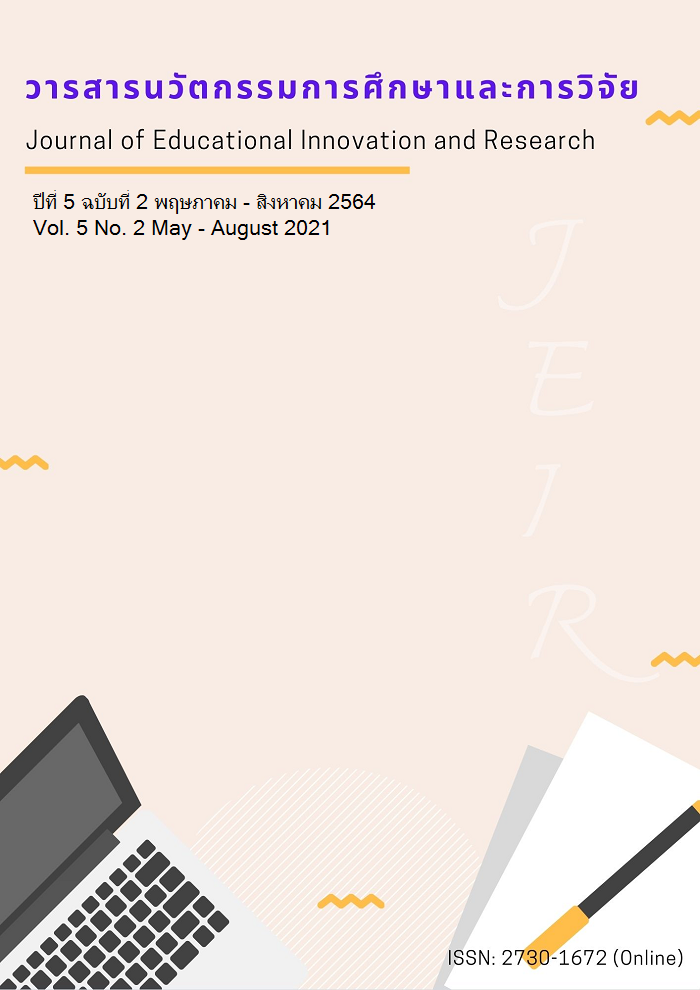การศึกษาผลสัมฤทธิ์ทางการเรียนของนักเรียนที่เรียนด้วยบทเรียนอิเล็กทรอนิกส์ (E-Learning) วิชา อ31203 การเขียนเรียงความภาษาอังกฤษ 1 นักเรียนชั้นมัธยมศึกษาปีที่ 4 โรงเรียนเทพศิรินทร์
Main Article Content
บทคัดย่อ
บทความนี้มีวัตถุประสงค์ 1) เพื่อสร้างและหาประสิทธิภาพของบทเรียนอิเล็กทรอนิกส์ (E-Learning) วิชา อ31203 การเขียนเรียงความภาษาอังกฤษ 1 ของนักเรียนชั้นมัธยมศึกษาปีที่ 4 ให้มีประสิทธิภาพตามเกณฑ์ 80/80 2) เพื่อศึกษาผลสัมฤทธิ์ทางการเรียนของนักเรียนหลังเรียนที่เรียนด้วยบทเรียนอิเล็กทรอนิกส์ (E-Learning) วิชา อ31203 การเขียนเรียงความภาษาอังกฤษ 1 ของนักเรียนชั้นมัธยมศึกษาปีที่ 4 กลุ่มตัวอย่างที่ใช้ในการทดลอง คือ นักเรียนชั้นมัธยมศึกษาปีที่ 4 โรงเรียนเทพศิรินทร์ สำนักงานเขตพื้นที่การศึกษามัธยมศึกษา เขต 1 ภาคเรียนที่ 1 ปีการศึกษา 2563 จำนวน 47 คน ซึ่งได้มาโดยการสุ่มอย่างง่ายด้วยวิธีการจับสลาก (Simple Sampling Method) เครื่องมือที่ใช้ในการวิจัยครั้งนี้ได้แก่ 1) บทเรียนอิเล็กทรอนิกส์ (E-Learning) เรื่อง การเขียนเรียงความภาษาอังกฤษ วิชา อ31203 ของนักเรียนชั้นมัธยมศึกษาปีที่ 4 2) แผนการจัดการเรียนรู้ด้วยบทเรียนอิเล็กทรอนิกส์ วิชา อ31203 การเขียนเรียงความภาษาอังกฤษ สำหรับชั้นมัธยมศึกษาปีที่ 4 และ 3) แบบทดสอบวัดผลสัมฤทธิ์ทางการเรียน เรื่อง การเขียนเรียงความภาษาอังกฤษที่มีค่าความเชื่อมั่นเท่ากับ 0.83 สถิติที่ใช้ในการวิเคราะห์ข้อมูล คือ ค่าเฉลี่ย ส่วนเบี่ยงเบนมาตรฐาน และการทดสอบค่าทีที่เป็นอิสระต่อกัน (t-test dependent sample) ผลการวิจัยพบว่า
1) ประสิทธิภาพของบทเรียนอิเล็กทรอนิกส์ วิชา อ31203 เรื่อง การเขียนเรียงความภาษาอังกฤษ 1 ของนักเรียนชั้นมัธยมศึกษาปีที่ 4 มีค่าประสิทธิภาพเท่ากับ 83.40/84.89 ซึ่งเป็นไปตามเกณฑ์ประสิทธิภาพ 80/80 ที่กำหนดไว้
2) ผลสัมฤทธิ์ทางการเรียนของนักเรียนที่เรียนด้วยบทเรียนอิเล็กทรอนิกส์ (E-Learning) วิชา อ31203 การเขียนเรียงความภาษาอังกฤษ 1 ของนักเรียนชั้นมัธยมศึกษาปีที่ 4 หลังเรียน (M = 26.87, S.D. = 1.71) สูงกว่าก่อนเรียน (M = 25.00, S.D. = 2.09) อย่างมีนัยสำคัญทางสถิติที่ระดับ .05
Article Details
References
กระทรวงศึกษาธิการ. (2551). หลักสูตรแกนกลางการศึกษาขั้นพื้นฐาน พุทธศักราช 2551. กรุงเทพฯ:
โรงพิมพ์ชุมนุมสหกรณ์การเกษตรแห่งประเทศไทย จำกัด.
กระทรวงศึกษาธิการ. (2562). พระราชบัญญัติการศึกษาแห่งชาติ (ฉบับที่ 4) พ.ศ. 2562. กรุงเทพฯ: กระทรวงศึกษาธิการ.
กิตติศักดิ์ สิงห์สูงเนิน และณมน จีรังสุวรรณ. (2558). Google for Education กับการปฏิรูป การศึกษาไทย. วารสารพัฒนาเทคนิคการศึกษา, 28(96), 14-20.
จินตวีร์ คล้ายสังข์. (2556). การพัฒนารูปแบบการเรียนอีเลิร์นนิงแบบผสมผสานศาสตร์การสอนตามแนวทางคอนสตรั๊คติวิสต์ด้วยเครื่องมือทางปัญญาเพื่อเสริมสร้างการสร้างความรู้ ของผู้เรียนในระดับอุดมศึกษา (รายงานการวิจัย). จุฬาลงกรณ์มหาวิทยาลัย.
ถนอมพร เลาหจรัสแสง. (2545). Designing E-Learning หลักการออกแบบและการสร้างเว็บเพื่อการเรียนการสอน. กรุงเทพฯ: ศูนย์หนังสือแห่งจุฬาลงกรณ์มหาวิทยาลัย.
ธนวรรณ เจริญนาน และคณะ. (2562). ผลการจัดกิจกรรมการเรียนรู้ออนไลน์ด้วย Google Classroom เรื่อง การสร้างสรรค์ชิ้นงานด้วยไมโครซอฟท์เพาเวอร์พ้อย สำหรับนักเรียนชั้นประถมศึกษาปีที่ 6. (รายงานการวิจัย): วารสารศึกษาศาสตร์ มมร, 7(1), 381-396.
นพมาตร พวงสุวรรณ. (2562). การศึกษาข้อผิดพลาดการเขียนย่อหน้าภาษาอังกฤษเบื้องต้น ของนักเรียนระดับชั้นมัธยมศึกษาตอนปลาย โรงเรียนเทพศิรินทร์ (รายงานการวิจัย) โรงเรียนเทพศิรินทร์.
บุญเดือน คูสุวรรณ. (2547). การใช้กิจกรรมเชิงสร้างสรรค์เพื่อส่งเสริมการเขียนภาษาอังกฤษ
เชิงสร้างสรรค์และความคิดสร้างสรรค์สำหรับนักเรียนชั้นมัธยมศึกษาตอนปลาย. (วิทยานิพนธ์ครุศาสตรมหาบัณฑิต). มหาวิทยาลัยราชภัฏเชียงราย.
โรงเรียนเทพศิรินทร์. (2563). หลักสูตรโรงเรียนเทพศิรินทร์ ปีการศึกษา 2563. กรุงเทพมหานคร: โรงเรียนเทพศิรินทร์.
อมรินทร์ อำพลพงษ์. (2559). การพัฒนาบทเรียนบนเครือข่ายอินเทอร์เน็ตตามแนวทฤษฎี คอนสตรัคติวิสต์ เพื่อส่งเสริมความสามารถในการออกแบบและเทคโนโลยี ของนักเรียนชั้นมัธยมศึกษาปีที่ 4 โรงเรียนสาธิตจุฬาลงกรณ์มหาวิทยาลัย ฝ่ายมัธยม (รายงานการวิจัย). คณะครุศาสตร์ จุฬาลงกรณ์มหาวิทยาลัย
Allen, I. E.; & Seaman, J. (2005). Growing by Degree: Online Education in the United States. Retrieved
September 11, 2020, http://sloanconsortium.org/resources/growing_by_degrees.pdf
Emily Kissner. (2006). Summarizing, Paraphrasing, and Retelling: Skills for Better Reading, Writing, and Test Taking. New Hampshire: Heinemann.
Heaton, J.B. (1988). Writing English Language Test. London: Group.
Jacob D.L. and et al. (1983). Testing ESL Composition: A Practical Approach. Massachusetts: Newbury House Publisher.
Palmer, A. S., Kimball, M.C. (1981).A criterion-based composition grading system. In Khoo, R. (ed.) Guidelines for writing activities. Singapore: SEAMEO Regional Language Centre.
Ritchie, Don C., and Bob Hoffman. (1997). Incorporating Instruction Design Principles with the world Wide Web. In Education Technologies.135-138. Edited by Khan. Englewood Cliffs: Educational Technologies Publication.
Smith, P. L. & Ragan, T. J. (2005). Instructional design (3rd ed.). New Jersey: John Wiley & Sons.
Walker, J. W. (1992). Human Resource Strategy. New York: McGraw-Hill.
White, V. W. (1980). Teaching Written English. Great Britain: George Allen and Unwin.

